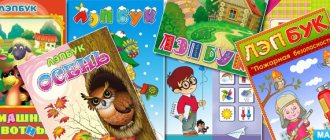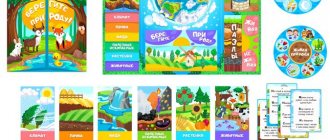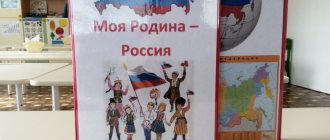Lapbook “My small Motherland, my Borovsky native”
Author:
Domnina Alina Mikhailovna
teacher
MADO Borovsky kindergarten "Zhuravushka"
Using a lapbook in working with preschoolers to form children’s primary ideas about their small homeland
Goal: Formation of primary ideas about the small homeland through the use of lapbooks in children of primary preschool age
Tasks:
- expand children’s knowledge about their native village of Borovsky: about the sights, monuments, objects located on the streets of the village; about the most significant enterprises of the village; nationalities living in the village;
— to cultivate love, respect and affection for one’s small Motherland;
-develop children’s cognitive interest, coherent speech, enrich and activate their vocabulary.
According to the Federal State Standard for Preschool Education, cognitive development involves the formation of preschoolers’ primary ideas about their small Motherland and Fatherland, and ideas about sociocultural values.
It is known that preschool age is the most important period in the formation of personality, when the prerequisites for civic qualities and patriotic feelings are laid, and although they are still elementary in their manifestations, they are extremely important for the further formation of personality. Love for the small Motherland begins with the attitude towards loved ones, towards the house, the street where the child lives, towards the kindergarten, towards the native village; with the assimilation of norms of behavior, familiarization with cultural values. After all, impressions about the place where a person grew up, about the history of his native land, received in childhood, remain for life.
Thus, the formation of primary ideas about the small Motherland among preschoolers is an urgent problem in the educational process of preschool educational institutions.
3 - 4 slide Every preschool teacher is always in search of new forms of organizing educational activities. In our work with children on the formation of primary ideas about their small Motherland, the result of such a search was a lapbook.
The laptop “My small Motherland, my Borovsky native” is a cube, on each face of which there are informative pockets. Inside the pockets there are didactic games and educational material about their native village. The pockets are attached to Velcro tape (“Velcro”), which allows children to use the pocket separately from the laptop and change pockets.
I would like to note that this type of laptop was not chosen by chance. It is made of a material that is easy to process, which is important nowadays.
The laptop meets all the requirements of the Federal State Educational Standard for Educational Education for a subject-spatial developmental environment:
- informative
- functional
- has didactic properties
- has a variable function (there are several options for using each part of it)
- provides playful, educational, research and creative activity for all pupils
- It helps the child organize information on the topic being studied at will.
- Children learn to independently collect information and use it.
- The laptop is well suited for individual and group lessons. Suitable for repeated use.
5-6 slide Pocket “Nationalities living in the village.” Goal: Formation and consolidation of knowledge about the multinationality of our village. Introduce national clothing. Instill interest in national culture. Development of color perception through the national costumes of peoples. Fostering respect for other nations.
The pocket contains cards depicting costumes of different nationalities: Tatars, Bashkirs, Kazakhs, Russians and Ukrainians. In order to arouse children's interest in studying the peoples living in our village, two types of pictures were made: the original version and for the game “Find a Pair”. Using the sample, and then without any prompts, you need to learn how to select a pair of national costumes.
Slide 7 Pocket “Sights, monuments of the native village.” Purpose: Expanding children’s knowledge about the sights, monuments, architectural buildings of the native village.
This pocket contains photographs of significant objects in the village of Borovsky.
Pupils can independently look at photographs of sights and monuments of the village of past years and see how they have changed and look like now.
When working with this material, preschoolers have the opportunity to compare, analyze, and talk about their favorite places. It should be noted that this pocket is constantly replenished with photographs from family albums, albums of grandparents, as well as photographs of favorite family vacation spots. Thus, children begin to get acquainted with the history of the village.
8 slide To motivate preschoolers, this pocket contains the game “Collect a picture.” Children are happy to collect the picture, at the same time remember and talk about the selected object.
9-10 slide Pocket “Dishes of different nationalities”. Goal: Formation of children's understanding of dishes of different types of national cuisine.
When studying the presented material, pupils get acquainted with their favorite dishes of different nationalities. Children look at pictures with images of certain dishes, learn the names of the dishes, and also have the opportunity to talk about their family’s favorite dish. In this pocket there is a game “Composition of a dish”: a picture is selected depicting a certain dish (to begin with, everyone knows), children need to select cards depicting the ingredients that are included in the selected dish. The game promotes the development of memory, attention, thinking, develops children's horizons and coherent speech.
11 – 12 slide Pocket “Professions of our parents, enterprises of the village.” Goal: Expanding and systematizing children’s knowledge about the world of professions using the example of the professions of their parents, as well as enterprises located in the village.
13 -14 slide Pocket “Folk folklore and traditions”. Goal: To develop children's interest in folk art, folklore, and traditions.
At the moment, in this pocket there are coloring cards depicting the nursery rhymes, rhymes and songs that we have studied. On the back of each card is a hint text for the teacher. Children can choose a card, remembering a familiar nursery rhyme, and color it as they wish. The cards are laminated, which allows them to be reused. This pocket is often replenished by parents who willingly share their knowledge of the nursery rhymes and songs that they use at home with their children. Thus, parents share their experience with the teacher, which helps to establish a trusting relationship.
15 slide The “Question Mark” pocket is designed to supplement the lapbook with information about their native village as children grow older. Very soon, preschoolers will get acquainted with the symbols of the village, learn about the coat of arms and flag, the history of the village, and outstanding people.
Thus, the use of the lapbook “My Small Motherland, My Borovsky Dear” contributes to the formation of children’s primary ideas about their small homeland. Through play activities, children, unnoticed by themselves, acquire and consolidate knowledge about their native village.
Lapbook “My Perm Region”
Municipal autonomous preschool educational institution "Platoshinsky kindergarten "Solnyshko"
Lapbook on the topic: “My Perm region”
Author-compiler: Medvedeva Elena Nikolaevna
teacher
Municipal autonomous preschool educational institution "Platoshinsky kindergarten "Solnyshko"
Lapbook on the topic: “My Perm region”
Author-compiler: Medvedeva Elena Nikolaevna
teacher
Target:
development of children’s coherent speech using the didactic manual lapbook “My Perm Region”.
Tasks:
- Develop coherent speech in children.
- To form children’s ideas about their small homeland.
The “My Perm Region” laptop is a homemade folder with pockets, notepads, accordions, envelopes, and movable parts that a child can take out, rearrange, and fold at his own discretion.
On the first page, it is called “Cities of the Perm Territory”, there are:
- Envelope “Cities of the Perm Territory”, in the envelope there are photos of the most famous cities of the Perm Territory, interesting facts about them.
- Notebook “Coats of arms of the cities of the Perm region” with illustrations of the coats of arms of the most famous cities,
- Accordion “Proverbs of the native land”,
- The “This is Interesting” envelope contains information about the most interesting places in the Perm region.
- Pocket “Puzzles “Hometown””, in which there is an image of the symbol of the city of Perm and a set of puzzles.
The second page is called “The Pride of Our Land” and contains:
- Four envelopes on the topic: “Famous people of the Perm region”, “What is the Perm region famous for”, “Minerals”, “The most unusual monuments of the Perm region” with an image and their description,
The third page is called “Animal World”, it contains:
- Envelope “Red Book of the Perm Territory”, which contains cards with images of animals, birds, fish listed in the book.
- Secret "Riddles about animals."
- Accordion "Classification of Animals".
- Envelope “Creative task”, the purpose of which is the development of coherent speech (retelling, conversation, reading).
- Memory game, the purpose of which is to consolidate knowledge of the appearance and names of animals, birds, fish of the Perm region; the ability to distinguish and compare pictures with each other, name them correctly; development of memory, ability to concentrate.
The fourth page is called: “Plant world”, it contains:
- Three envelopes with illustrations on the theme: “Trees”, “Herbs”, “Mushrooms”;
- Envelope on the theme: “Color the plant”
- Envelope "Tale based on the picture."
Also in the lapbook there is an application that contains mnemonic tables that help to compose descriptive stories (“Tell about the animal”, “Tell about the plants”, “Tell about the birds”, “Tell about the insects”). Didactic games: “Verbal game “Why”, “Accounting Pedestal”, “City Coat of Arms”, “The Fourth Odd One”, “Animals of Our Land” - which are aimed at developing coherent speech, and also help consolidate knowledge of the material collected in the folder.
7
Lapbook as a type of project activity “My Altai has many faces”
- December 5, 2016
Competition “Lapbook as a learning tool in the conditions of the Federal State Educational Standard”
Nomination “Use of a laptop in the pedagogical activities of a preschool teacher”
Goal: to create conditions for the effective use of new technology - an interactive folder (lapbook) to consolidate children's knowledge about their small homeland - the Altai Republic.
Tasks:
1) study and select material on the topic “Getting to know the Altai Republic”; 2) make diagrams, pockets, plot pictures, photos; 3) expand children’s ideas about their native republic, know the location of regions, mountains, rivers, lakes; 4) to form ideas about the Motherland, filling it with emotionally rich content that is meaningful for children, to introduce them to the symbols of Russia and the Altai Republic; 5) consolidate knowledge about the sights of our republic, nature and its wealth; 6) arouse interest in the life of people, flora and fauna; 7) cultivate respect for the traditions of one’s own and other peoples; organize master classes on making lapbooks with parents.
2) make diagrams, pockets, plot pictures, photos; 3) expand children’s ideas about their native republic, know the location of regions, mountains, rivers, lakes; 4) to form ideas about the Motherland, filling it with emotionally rich content that is meaningful for children, to introduce them to the symbols of Russia and the Altai Republic; 5) consolidate knowledge about the sights of our republic, nature and its wealth; 6) arouse interest in the life of people, flora and fauna; 7) cultivate respect for the traditions of one’s own and other peoples; organize master classes on making lapbooks with parents.
Stages of working on a laptop:
- At the preparatory stage, we studied materials about lapbooks from the methodological magazine “Preschool Education”, from the site “This is Interesting!” (tavika.ru);
- The main stage is the creation of a lapbook “My Altai has many faces,” which consists of 10 developmental elements.
- at the final stage we plan to organize an exhibition of lapbooks - joint works of teachers, parents and children on various topics: “Lazar Vasilyevich Kokyshev - two paths: creative and life!”, “Types of Altai national dwellings”, “Altai fairy tales”, “G.I. Choros-Gurkin – artist of Altai”, etc.
The interactive thematic folder “My Altai has many faces,” which we made together with the children, will store lesson materials about our Altai Republic. This folder consists of 10 developmental elements :
1. Envelope in the shape of mountains – didactic game “Symbolics of the Altai Republic”. Here you can find the games “Gather a Picture” (make a whole from parts) for younger preschoolers, and for older children – analysis of colors and images on symbols, as well as “Smart Stripes”.
2. Mini-book “Altai proverbs and sayings, folk riddles” for guessing riddles on the topics “Nature and natural phenomena”, “Plants”, “Animal world”, “Pets”, “Man and his life”, “Homeland. People”, etc. It is designed to train memory and intelligence. Each page has a riddle with picture answers (riddles and proverbs are added as you become more familiar with the topic).
3. Figured envelope “Regions of the Altai Republic”, cards are placed in the envelope. Children should know the regions of the republic. What is this or that area famous for? There is also a map of the republic, folded in four (the child unfolds it when completing the task).
In the middle of the lapbook there is a green background, symbolizing the vegetation and wealth of the republic.
4. Accordion book “Animals of the Altai Republic”. Serves to enrich the child’s knowledge about the surrounding nature of his republic, including animals and their habitat, rare animals listed in the Red Book.
5. “Nature of the Altai Republic” is presented in the form of an ordinary colorful book and a figured envelope - a flower, in which there are plot pictures of mountains, lakes and rivers, photographs where children consolidate knowledge and show admiration for the beauty of the world around them.
6. Figured book “Writers, artists, poets, storytellers of the Altai Republic.” Children talk about famous people of the republic, name their works, and are proud of them.
7. Envelope “The capital of the Altai Republic is the city of Gorno-Altaisk,” which contains photographs of the old and modern city of Gorno-Altaisk, the capital of the Altai Republic. Children compare how the city has changed and name the sights.
8. The educational element “Altai Ornament” will help the child not only name patterns correctly, but also prepare for writing. Children draw patterns based on the model.
9. The transparent envelope “Make a story based on the picture” is aimed at reinforcing the compilation of descriptive stories based on the reproduction of a painting by Altai artists.
10. The creative task “Color and Tell” contains a variety of tasks for the development of not only creative abilities, but also cognitive and communicative ones.
Our little flip book packed a lot of information into a very attractive and interesting format. But everyone can do it in their own way and, most importantly, together with their children. Children treat the product of their creativity very carefully and proudly tell and show it.
Such an unusual presentation of the material will definitely attract the child’s attention, and he will return to this folder more than once to look through it, play with it, and at the same time, unbeknownst to himself, repeat the material he has covered.
Effectiveness of using a laptop:
1. A laptop is an effective tool for cooperation with parents of students. Parents provide support:
- organizational (excursions, hikes, trips)
- technical (photos, videos, drawings)
- cognitive and informational (collecting information for a laptop)
- motivational (maintaining interest, creating a situation of success)
2. Working with a lapbook meets the main theses of organizing partnership activities between an adult and children, as pointed out by N.A. Korotkova:
- involvement of the teacher in activities on an equal basis with the children;
- voluntary participation of preschoolers in activities (without mental and disciplinary coercion);
- free communication and movement of children during activities (subject to the organization of the workspace);
- open time end of activity (everyone works at their own pace).
3. The laptop meets the requirements of the Federal State Educational Standard for Educational Education for a developing subject-spatial environment: it is informative, multifunctional, and promotes the development of creativity and imagination. Suitable for use by a group of children at the same time (including with the participation of an adult as a playing partner); has didactic properties; is a means of artistic and aesthetic development of the child, introduces him to the world of art; its structure and content are accessible to preschool children; provides playful, educational, research and creative activity for all pupils.
As a result of using a laptop, children develop:
- ability to plan upcoming activities;
- negotiate with peers;
- independently provide explanations to questions that arise;
- make your own decisions based on your knowledge and skills;
- distribute responsibilities;
- search for the necessary information, summarize it, systematize it;
- make your own decisions based on your knowledge and skills;
- Using oral speech, express your thoughts and desires.
Thus, we can say that a lapbook on the topic “My Altai has many faces” is a collective image of a book and handouts that is aimed at developing creative potential in preschoolers, broadening their horizons, developing the skills and abilities necessary to overcome difficulties and solve the problem - consolidation of knowledge about the Altai Republic.
I would like to note that this form of work helps to create conditions to support children's initiative and creativity in the group. In the process of such creativity, the child becomes not only the creator of his own book, but also a designer, illustrator, and writer of his own stories, riddles, and poems. This exciting form of work creates conditions for the development of the child’s personality, motivation and abilities not only in preschool age, but also at the school stage.
This form of work in child-adult interaction, both together with teachers and family projects, develops more trusting relationships when working with families, increases parental (professional) competence and makes it possible not only to recognize the interests and potential of a preschooler, but also to develop them.
Lapbook “My Altai has many faces”
Author: Natalya Mikhailovna Tanzykova, teacher, kindergarten “Topolyok”, Municipal Educational Institution “Paspaulskaya Secondary School”, Altai Republic, S. Paspaul.





